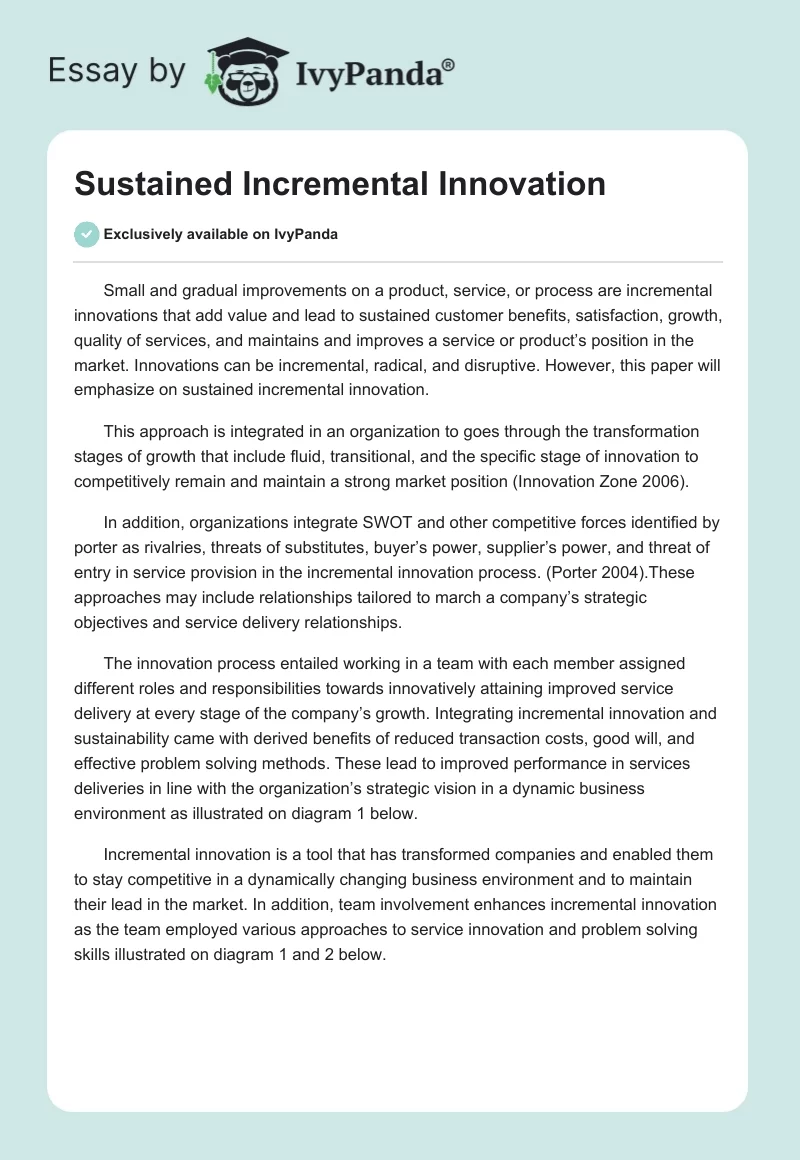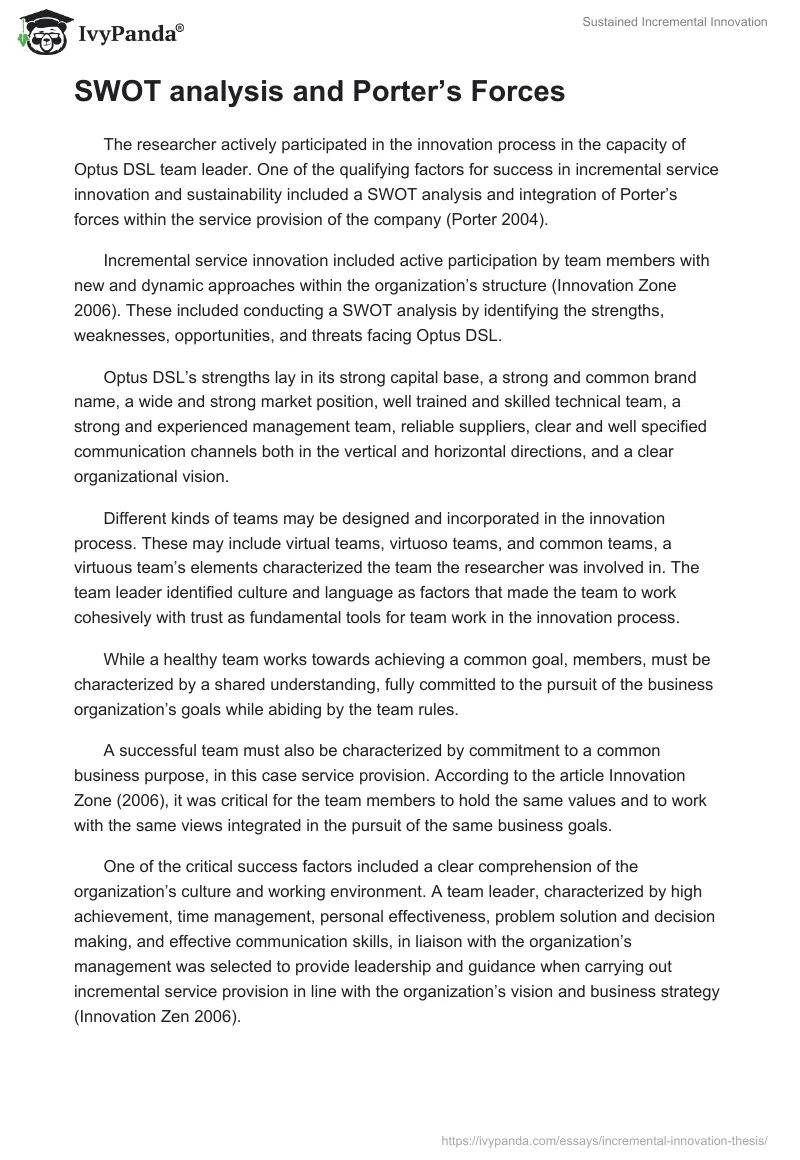Small and gradual improvements on a product, service, or process are incremental innovations that add value and lead to sustained customer benefits, satisfaction, growth, quality of services, and maintains and improves a service or product’s position in the market. Innovations can be incremental, radical, and disruptive. However, this paper will emphasize on sustained incremental innovation.
This approach is integrated in an organization to goes through the transformation stages of growth that include fluid, transitional, and the specific stage of innovation to competitively remain and maintain a strong market position (Innovation Zone 2006).
In addition, organizations integrate SWOT and other competitive forces identified by porter as rivalries, threats of substitutes, buyer’s power, supplier’s power, and threat of entry in service provision in the incremental innovation process. (Porter 2004).These approaches may include relationships tailored to march a company’s strategic objectives and service delivery relationships.
The innovation process entailed working in a team with each member assigned different roles and responsibilities towards innovatively attaining improved service delivery at every stage of the company’s growth. Integrating incremental innovation and sustainability came with derived benefits of reduced transaction costs, good will, and effective problem solving methods. These lead to improved performance in services deliveries in line with the organization’s strategic vision in a dynamic business environment as illustrated on diagram 1 below.
Incremental innovation is a tool that has transformed companies and enabled them to stay competitive in a dynamically changing business environment and to maintain their lead in the market. In addition, team involvement enhances incremental innovation as the team employed various approaches to service innovation and problem solving skills illustrated on diagram 1 and 2 below.
SWOT analysis and Porter’s Forces
The researcher actively participated in the innovation process in the capacity of Optus DSL team leader. One of the qualifying factors for success in incremental service innovation and sustainability included a SWOT analysis and integration of Porter’s forces within the service provision of the company (Porter 2004).
Incremental service innovation included active participation by team members with new and dynamic approaches within the organization’s structure (Innovation Zone 2006). These included conducting a SWOT analysis by identifying the strengths, weaknesses, opportunities, and threats facing Optus DSL.
Optus DSL’s strengths lay in its strong capital base, a strong and common brand name, a wide and strong market position, well trained and skilled technical team, a strong and experienced management team, reliable suppliers, clear and well specified communication channels both in the vertical and horizontal directions, and a clear organizational vision.
Different kinds of teams may be designed and incorporated in the innovation process. These may include virtual teams, virtuoso teams, and common teams, a virtuous team’s elements characterized the team the researcher was involved in. The team leader identified culture and language as factors that made the team to work cohesively with trust as fundamental tools for team work in the innovation process.
While a healthy team works towards achieving a common goal, members, must be characterized by a shared understanding, fully committed to the pursuit of the business organization’s goals while abiding by the team rules.
A successful team must also be characterized by commitment to a common business purpose, in this case service provision. According to the article Innovation Zone (2006), it was critical for the team members to hold the same values and to work with the same views integrated in the pursuit of the same business goals.
One of the critical success factors included a clear comprehension of the organization’s culture and working environment. A team leader, characterized by high achievement, time management, personal effectiveness, problem solution and decision making, and effective communication skills, in liaison with the organization’s management was selected to provide leadership and guidance when carrying out incremental service provision in line with the organization’s vision and business strategy (Innovation Zen 2006).
Successful service innovation was a characterizing hallmark for the team. The strategic approach to success was characterized by a functional approach that thrived on an in-depth analysis of the service problem which relied on an excellent decision making process in the innovation process (Burnett 1996).
Baumgartner (2009) argues a comprehensive innovation structure should be embedded in an organization where the innovation team should identify the actual problem or challenge at hand. In-depth analysis of the problem was done through a brainstorming session. The problem included declining customer numbers, dissatisfied customers, declining profits, and poor service delivery. The project commenced and ended as illustrated on figure 2 below.
The creative abilities of the team members were effectively and efficiently utilized through team and management collaborations. The problems were identified and through these collaborations, a number of potential solutions were generated. In addition to that, the team’s effectiveness was identified when new data about the problems were presented.
Baumgartner (2009) asserts that a number of these new data and ideas were combined while the team went further to consider the potential solutions. A satisfied team emerged with team members entirely satisfied with the problem definition, their inputs, and solutions suggested for the problems.
Baumgartner (2009) identifies a Scientific Peer Review Evaluation approach to service innovation as the basis of service innovation. This stage was identified by intense discussions on the best approach to service innovation. Team members did not participate equally though disparities were always kept checked. Uneven participation in the discussion was identified with the potential create uneven participation in the innovation process illustrated on diagram 4.
In addition, gender and organizational culture were critical issues considered in the discussion. Success in the team evolved around the leader and team members’ abilities to recognize varied viewpoints as conflicts that stemmed from a healthy approach to problem solutions could be amicably resolved.
The Thought Process
The innovation process went through a period of intense discussions on appropriate solutions by team members. According to the article The Thought Process (n.d), team remember went through a mental process characterized by reasoning by inferring on previous experience and available data and knowledge, deductive reasoning where logical analysis was done on available information, inductive reasoning, and adductive reasoning where actions that cause results were critically evaluated.
Then team members entered the problem solving stage of finding solutions to problems on service provisions and sustainability based on Gestalt’s theory illustrated on figure 5. The theory asserts problem solving draws on both insight and experience. The discussion also centered on conducting a gap analysis on the company’s services delivery to identify service provision gaps.
Business Situation and Virtuous team
Selecting a virtuous team depended on the business situation of the company in question. According to Lovelock, Patterson, and Walker (2007), the business organization was characterized by a wide area of coverage and customer base. While the virtuous team, a variant of a face-to-face team, could operate in a confined environment, interaction between virtuous team members was highly accelerated as the business environment was in a dynamically evolving technological environment (Lovelock, Patterson, Walker, & 2007).
The virtuous team was characterized by a critical approach that entailed quick actions, viewing work as being critical, expertise team members well skilled in their area of service, and members who stimulated one another. In addition, team members had high esteem viewing challenges as acceptable and risk worthy their undertakings, and excellent output while tension and conflict could be used constructively.
Failure was checked as it could put to risk the team members careers and confrontation was used for the organization and team members’ healthy growth. All these elements were factored to enhance the performance of the team in pursuing the organization’s vision and business goals.
References
Baumgartner (2009) Innovation Process Management (IPM). Web.
Burnett, J.J. (1996). Journal of Service Marketing. What services marketers need to know about the mobility- disabled consumer. Volume 10. MCPUP Ltd.
Innovation Zen (2006). The Abernathy-Utterback Model. Web.
Lovelock, C.H., Patterson, P.G., Walker, R.H. (2007). Services marketing: an Asia-Pacific and Australian perspective / Christopher H. Lovelock, Paul G. Patterson, Rhett H. Walker. (4th ed.) NSW: Pearson Prentice-Hall.
The Thought Process (n.d). Web.
Porter, M. E. (2004). Competitive Advantage. Free Press New Edition. U.K.


